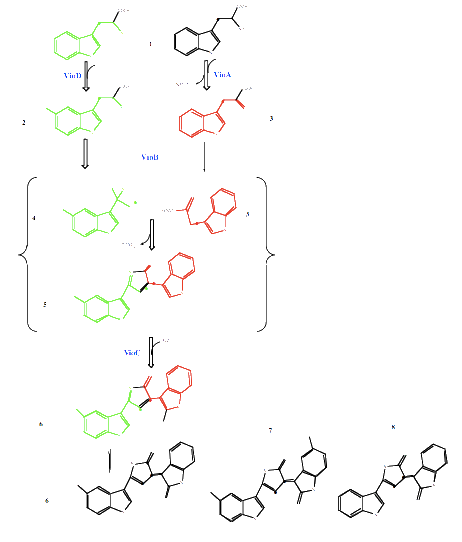Team:Cambridge/Project/Violacein
From 2009.igem.org
Categories :
Project :
-
Overview
Sensitivity Tuner
--- Characterisation
--- Modelling
Colour Generators
--- Carotenoids (Orange/Red)
--- Melanin (Brown)
--- Violacein (Purple/Green)
The Future
Safety
Notebook :
Team Logistics :
Violacein Pigment
Introduction
The Violacein pigment is produced from L-tryptophan via a pathway involving four enzymes, VioA-D. This scheme is shown below:
From P.R. August, T.H. Grossman, C. Minor, M.P. Draper, I.A. MacNeil, J.M. Pemberton, K.M. Call, d. Holt, and M. S. Osbourne, Sequence Analysis and Functional Characterization of the Violacein Biosynthetic Pathway from Chromobacterium violaceum, J. Mol. Microbiol. Biotechnol. (2000) 2(4): 513-519. [http://www.horizonpress.com/jmmb/v2/v2n4/26.pdf]
Further, as module 5 is Aqua, controlling VioA, VioB, VioC, and VioD allows us to generate two different pigments, aqua and violet.
Our VioA-D genes are from Chromobacterium voilaceum.
Previous Work
Duncan Rowe provided us with the VioA-D operon on the pPSX-Vio+ plasmid, a very low copy number plasmid. We transformed Top10 E. coli with pPSX-Vio+ and made our own plasmid stocks.
Action plan of our team
Our action plan is as follows:
1. Test for violacein pigment production
2. Synthesize the violacein operon without any forbidden restriction sites to make it bio-brick compatible, and bio-brick the individual genes of the operon.
3. Produce aqua pigment.
Test activity of X
Mapping of Biobrick X: (image)
Construct composite Biobrick X
Plan mapping of X:
(image)
 "
"
